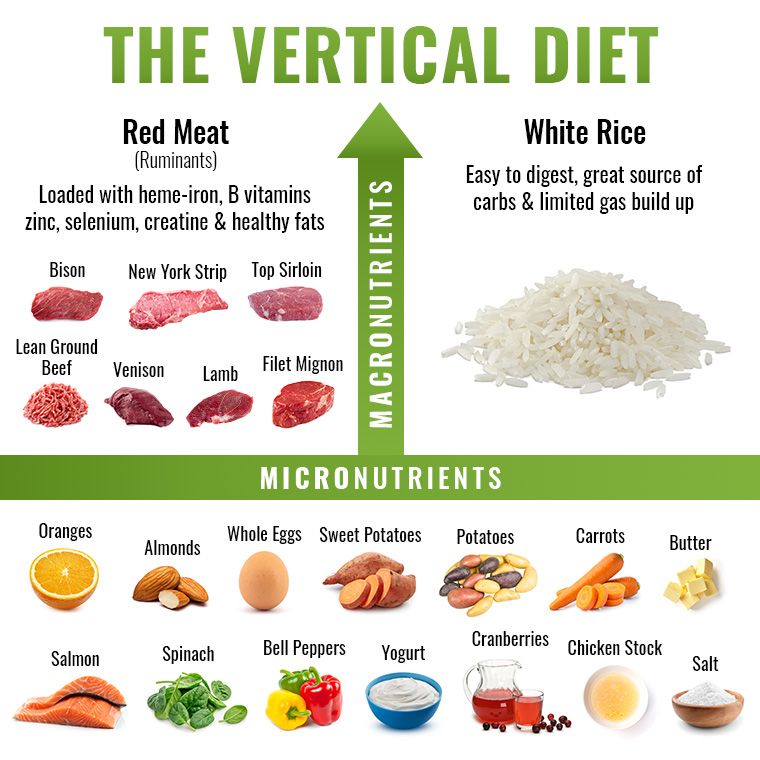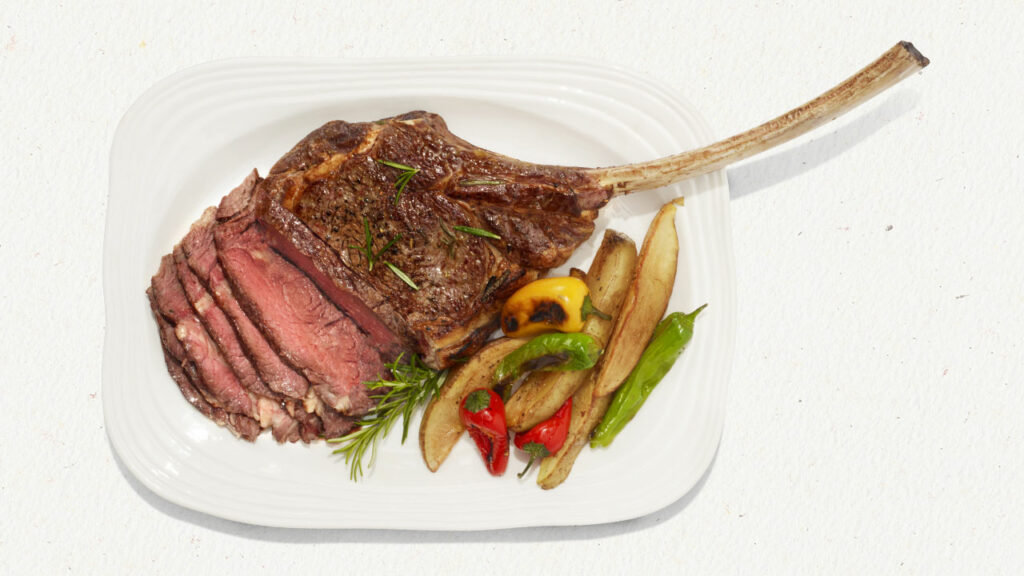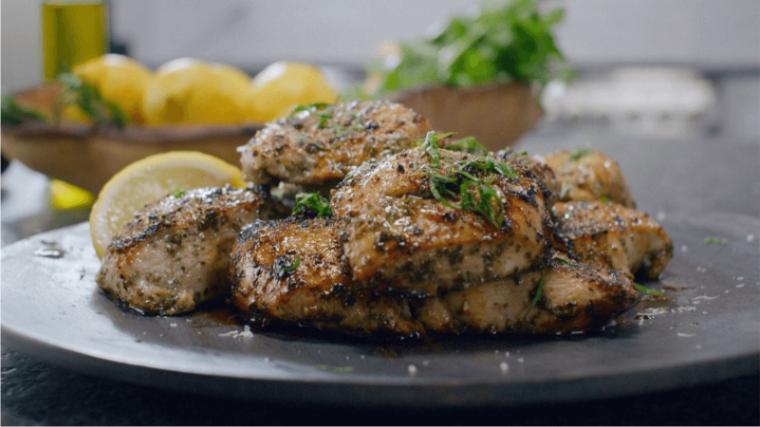Even if you’re mixing up one of the best protein powders each morning, adjusting your diet can still be necessary to build muscle mass. To gain weight, you need to be in a calorie surplus — consuming more calories than you burn. For some, though, beefing up your meals can take a toll on your digestive system. World-renowned bodybuilder, powerlifter, and nutrition coach Stan Efferding believes he’s developed a solution to this problem: the Vertical Diet.
Efferding’s approach aims to aid in food digestion and correct micronutrient deficiencies. The Vertical Diet has begun to trickle into the mainstream, attracting attention from outside the bodybuilding community. But is the Vertical Diet right for the average gymgoer? Read on to see what our team of registered dietitians and nutrition coaches have to say about this popular regimen.
What is the Vertical Diet?
The vertical in Vertical Diet simply refers to how it’s laid out — like an upside-down T. As our expert reviewer Kathleen Benson lays out, the plan itself serves two main purposes. “The Vertical Diet is a nutritional plan focused on reducing negative digestive health symptoms, while enhancing sports performance,” she says.

At the base of the upside-down T, you’ll find foods that Benson says can provide key micronutrients (vitamins and minerals) for organ health, hormone regulation, and more. “It prioritizes nutrient-dense foods, including red meat, low-lactose dairy foods, and white rice.”
The top of the graph highlights two important foods Benson mentions: red meat and white rice. For anyone concerned about how to count macros, these two staples are replete with protein, carbohydrates, and fats. The amount you eat depends on your strength and physique goals.
Why red meat and white rice? Efferding says those foods are the best way to get as many calories as possible without disrupting the body’s digestion system. And the rest of your foods — found at the bottom — can help aid digestion and other bodily functions.
“In short, the Vertical Diet is about eating nutrient-dense foods that are easily digestible to help you lose or gain weight, maximize workouts, and achieve better nutrient absorption overall,” he explains. “The goal is to keep the main focus on micronutrients such as vitamins, minerals, and antioxidants.”
As Benson notes, all the foods picked by Efferding are low-FODMAP foods. “[The Vertical Diet] eliminates foods high in FODMAPs, which can be nutrient-dense but may cause digestive issues.”
What Can You Eat on the Vertical Diet?
Sorry, vegans, but red meat and white rice are on the menu. Because it’s so easily digestible and has practically no fiber, fat, or antinutrients, white rice is as clean a carb as they come. (1) Brown rice is off the menu because it contains a lot of “antinutrients,” which are said to be compounds that reduce the body’s ability to absorb essential nutrients (more on those later). (2)
Red meat is Efferding’s high-protein food of choice because he considers it the most nutrient-dense kind of meat. “[Red meat is] loaded with heme iron, B-vitamins, zinc, magnesium, creatine, and healthy fats.”

It’s worth noting that, though, dietitians and nutritionists in recent years have called on people to reduce their red meat intake, as it’s been linked to increased risks of cancer and cardiovascular diseases. (3) Recent guidelines state you should cap your red meat intake at 18 ounces per week, but you’ll blow past that if you’re eating it every day. Always consult your healthcare professional before trying out the Vertical Diet, taking on any nutrition plan, or attempting to alter your body composition. (4)
For those who choose to continue on this path, many of the calories will come from those two food sources alone. Sources of red meat include:
- Beef
- Bison
- Buffalo
- Lamb
Because they’re not as nutrient-dense as red meat, Efferding says to avoid white fish (like sole) and white meat (like chicken) when crafting your meal plan.
Beneath the towering pillars of red meat and white rice, you’ll find a wide, flat base of fruit, potatoes, sweet potatoes, spinach, red peppers, carrots, and juice. You’ll also find some extra animal products, like butter, broth, and fatty fish.
What Can’t You Eat on the Vertical Diet?
We know where Efferding lands in the matchup between brown rice vs. white rice, but our expert reviewer, Kathleen Benson, highlighted a few other items to avoid on the Vertical Diet. “Foods on the no list include brown rice, grains, legumes (beans, peas, lentils, etc.), coffee, added sugar, and high FODMAP foods like onions, garlic, broccoli, and sugar alcohols (which occur naturally in some vegetables).”

Below is a quick rundown of foods to leave on the shelf.
Grains
Whole grains like pasta, cereal, and bread are not part of the Vertical Diet because they contain gluten and phytic acid, which we’ll be discussing more later. Some dietitians balk at this advice, as whole grains have many essential micronutrients. Whole grains have also been linked to a lower risk of colon cancer and cardiovascular disease. (4)
Oats
Oats are usually bodybuilding staples, but their concentration of antinutrients makes them a no-go for Vertical Diet followers. Like other grains, though, the consumption of oats can reduce the risk of certain diseases. (4)
Legumes
While legumes — like beans, soybeans, lentils, and chickpeas — are considered a source of lectins, they can result in some gas buildup. (5) They’re permitted under the Vertical Diet if they’re soaked and fermented, though.
These staples of the Mediterranean diet are high in fiber and have been linked to lower risk of all-cause mortality and cardiovascular disease. (6)(7)
Processed Vegetable Oils
These are super high in Omega-6 fatty acids, too many of which have been pretty strongly linked to inflammation, heart disease, and obesity. Nutritional experts have been urging people to cut back on processed oils, so it may be a good idea to cut these out even if you don’t follow the Vertical Diet. (8)
Coffee
Citing research showing that coffee can cause dehydration and impairs digestion, Efferding says that saying goodbye to some pantry staples is worth it. (9) “I don’t eat foods I like. I eat foods that like me,” he says. “Getting your gut health and digestion in top shape might make you feel better than these everyday comfort staples.”

The polyphenols found in coffee may help reduce the risk of cancer, but these are also readily available in fruits and vegetables. (10)
Sugar Alcohols
Sugar alcohols are natural sweeteners like erythritol and xylitol, which are commonly used in protein bars or diet-friendly ice cream. Like grains and legumes, they may lead to indigestion in some folks.
High-Raffinose Vegetables
Perhaps the most controversial exclusion, cruciferous vegetables like broccoli, cauliflower, and asparagus are excluded from the Vertical Diet. Why cut these out? The culprit is raffinose, a sugar found in some veggies, grains, and legumes resistant to digestion and can sometimes cause gas.
While this is true, it’s undeniable that these high-FODMAP vegetables are some of the most nutrient-dense and low-inflammation foods out there. They have also been shown to reduce cell damage and cancer risk. (11)
Garlic and Onions
Garlic and onions are the foundation of the tastiest, savory meals, but they’re high FODMAP foods. While your food might lack some flavor, there’s no health risk in cutting out these aromatics. Plenty of low-FODMAP foods, like fennel, celery, bell peppers, or carrots, can all be used in their place.
What’s a FODMAP Food?
Before committing to the Vertical Diet, it’s important to school yourself in what exactly a FODMAP food is. “The FODMAP diet is an evidence-based, short-term therapeutic approach designed to reduce digestive symptoms and support a personalized care plan,” explains our expert reviewer, Kathleen Benson. “High-FODMAP foods contain specific carbohydrates: fermentable oligosaccharides, disaccharides, monosaccharides, and polyols.”
Carbs and fibers from high-FODMAP foods pass through your system undigested, fueling your gut bacteria and producing hydrogen gas in the process. The result? Let’s just say people might be socially distancing themselves from you for a bit.
As Benson explains, beginning a FODMAP-less diet like the Vertical Diet can be broken down into three phases:
- Phase 1: “Elimination of high FODMAP foods for 4 to 6 weeks. These foods, such as garlic, onion, apples, and ripe bananas, can cause gas, bloating, distention, and irregular stools in some people.”
- Phase 2: “Testing groups of foods individually to identify specific triggers.”
- Phase 3: “Developing a personalized plan based on the testing results.”
For some, an excess of these types of food can be more serious than just a little gas. In certain individuals, they can draw liquid into the intestines to produce diarrhea or lead to leaky gut syndrome.
By eliminating high-FODMAP foods, Efferding explains, the Vertical Diet aims to support optimal digestion and provide an answer for those wondering how to prevent bloating. “Since the diet is about easily digestible macronutrients, high-FODMAP foods are either limited or prepared in a manner that reduces digestive distress,” says Efferding. “Low-gas vegetables like spinach, cucumber, bell peppers, and potatoes are better than cruciferous vegetables for increasing the positive results from the diet.”
Benefits and Downsides of the Vertical Diet
As with any change in your diet, consult with your healthcare provider or dietitian before launching any new health and wellness plan. Also, consider these potential benefits and drawbacks of the Vertical Diet.
Benefits
Efferding developed the Vertical Diet with two clear goals: to aid digestion and address micronutrient deficiencies. BarBend expert reviewer Kathleen Benson agrees that it can offer some relief for those with digestion issues, but perhaps only in the short term. “The FODMAP diet is a therapeutic diet, meant to reduce digestive symptoms, and help healthcare providers determine the best course of action,” she says.
One study has shown that low-FODMAP foods may reduce exercise-related gastrointestinal symptoms. (12) That might be great news when you’re straining to get in one more deadlift, but as a long-term strategy? “It is not meant as a long-term approach to addressing digestive symptoms,” Benson adds. “It’s a therapeutic tool to identify and manage the root causes of some digestive issues, such as microbiome dysbiosis.”
An indirect benefit of following the Vertical Diet could also be revealing a previously unknown issue with your gut health. “Sometimes microbiome dysbiosis, or imbalance, can be the cause of gas and bloating experienced after eating garlic or onion,” says Benson. “A nutrition professional trained in the FODMAP diet, might then aim to balance the microbiome for the client to be able to consume garlic and onion down the line.”
Downsides
While research suggests that eating low-FODMAP foods can be good for people with conditions like Irritable Bowel Syndrome, it’s uncertain if it’s a good approach for the general public. Studies suggest that low-FODMAP lifestyles can result in nutrient deficiencies (because you’re eliminating so many foods) and altered gut bacteria, which can lead to other gastrointestinal issues. (13)(14)
“While taking high FODMAP foods out can help reduce or eliminate digestive symptoms, it doesn’t address the root cause as to why those symptoms are being experienced,” Benson says.
She also notes that cutting too many high-fiber foods can have its own impact on digestion. “Long-term avoidance of fiber-rich foods can negatively impact the microbiome… in the digestive system. While short-term elimination is often part of the plan of care, it’s not recommended to avoid these foods long-term.”
Antinutrients: Lectins, Phytic Acid
Before starting the Vertical Diet, it’s a good idea to have a grasp of antinutrients. Lectin (a naturally-occurring protein) and phytic acid (a natural plant antioxidant) are two such compounds that bind to and impair the digestion of minerals like magnesium, iron, and zinc. (15)(16) Remember, the point of the Vertical Diet is to eat foods that are chock full of micronutrients. So, wouldn’t it make sense to avoid anything preventing those vitamins and minerals being absorbed by the body?
Well, not exactly. Both of these compounds also have health benefits. Lectin has been linked to lower cancer risks, while phytic acid has been associated with lower risks of cardiovascular disease and kidney stones. Some people even take it as a supplement. (16)(15)
Many antinutrient studies also have one problem. They isolate the compound, then study its effect on the body in their pure form by observing their interaction with certain cells. But that’s not how our bodies work — lectin is often ingested alongside things like Vitamin C, which can counter the compound’s negative effects. (17)
The Vertical Diet does allow for foods high in these “antinutrients” to be consumed, but only if they’re soaked and fermented, which helps to reduce the potential negative effects of these compounds.
Vertical Diet Macronutrients
The Vertical Diet is generally a low-fat eating regimen and can be tailored to a high- or low-carb plan by adjusting the amount of food you eat. The total amount of calories you’ll eat per day depend on your basal metabolic rate and your workload, but the basic macronutrient profile looks something like this:
- Protein: 1 gram per pound of bodyweight
- Fat: 0.3 grams per pound of bodyweight
- Carbohydrates: the rest of your calories
To figure out your daily caloric needs, you’ll first have to figure out your basal metabolic rate — that’s the number of calories you burn just to live or maintain your weight. This can be figured out in a lab, but that’s expensive and time-consuming.
If you’re looking to lose weight, the only way is to remain in a calorie deficit. In our piece on how to gain muscle, we wrote that you’ll want to consume more than you expend — but not by much. “On average, you want to be eating just 200 calories (so, less than a pack of skittles) above your total daily energy expenditure (how many calories you burn in a day),” reads the piece.
“Eating any more might lead to the fat gain you are trying to avoid,” it continues. “If you’re still having trouble gaining muscle — and your workout routine and sleep are on point — try adding 100 calories.”
Final Word
Efferding’s system speaks for itself when you look at the people who utilize it. That said, these are people who are under constant supervision by some of the greatest minds in the sports nutrition world. Because it’s focused on helping food digest as efficiently as possible, it’s easy to see why its biggest followers are strongmen and powerlifters who consume up to 12,000 calories per day.
With that kind of volume, high-FODMAP, high-fiber, and high-fat foods — all off the table for Vertical Diet adherents — could potentially make it harder to get in the amount of food you require to keep performing at your best. For most people, the Vertical Diet may be best viewed as a short-term solution for addressing digestive issues or identifying more serious ailments like irritable bowel syndrome. Either way, it’s always best to consult with your healthcare provider or dietitian before beginning a new diet program.
Vertical Diet FAQs
What do you eat on the vertical diet?
On the vertical diet, expect to eat a lot of white rice and red meat. Why these two staples? White rice is a clean carb that can easily be digested and is very low in fiber, fat, and antinutrients. Efferding prefers red meat as a source of protein because it is loaded with heme iron, B-vitamins, zinc, magnesium, creatine, and healthy fats. You’ll also be able to consume fruit, potatoes, sweet potatoes, spinach, red peppers, carrots, juice, and some animal products, like butter, broth, and fatty fish.
Is the vertical diet good for weight loss?
The vertical diet was designed to help bodybuilders bulk up with minimal digestive issues. So while you could lose weight while following the Vertical Diet (by remaining in a calorie deficit), that’s not its intended purpose. Our expert reviewer Chelsea Rae Bourgeois also reminds us, “Sustainable weight loss often requires a change in our relationship with food, and a registered dietitian can help you navigate those changes safely.”
Who should follow the vertical diet?
The Vertical Diet was designed for bodybuilders interested in how to build muscle while avoiding digestive problems. Reducing or eliminating high-FODMAP foods may be beneficial for those with digestive issues, but may be best as a short-term solution. Always check with your healthcare provider or a registered dietitian before beginning any new diet plan.
References
- Fukagawa, N. K., & Ziska, L. H. (2019). Rice: Importance for Global Nutrition. Journal of nutritional science and vitaminology, 65(Supplement), S2–S3.
- Miyoshi, H., Okuda, T., Okuda, K., & Koishi, H. (1987). Effects of brown rice on apparent digestibility and balance of nutrients in young men on low protein diets. Journal of nutritional science and vitaminology, 33(3), 207–218.
- Lippi, G., Mattiuzzi, C., & Cervellin, G. (2016). Meat consumption and cancer risk: a critical review of published meta-analyses. Critical reviews in oncology/hematology, 97, 1–14.
- Gaesser G. A. (2020). Whole Grains, Refined Grains, and Cancer Risk: A Systematic Review of Meta-Analyses of Observational Studies. Nutrients, 12(12), 3756.
- Winham, D. M., & Hutchins, A. M. (2011). Perceptions of flatulence from bean consumption among adults in 3 feeding studies. Nutrition journal, 10, 128.
- Zargarzadeh, N., Mousavi, S. M., Santos, H. O., Aune, D., Hasani-Ranjbar, S., Larijani, B., & Esmaillzadeh, A. (2023). Legume Consumption and Risk of All-Cause and Cause-Specific Mortality: A Systematic Review and Dose-Response Meta-Analysis of Prospective Studies. Advances in nutrition (Bethesda, Md.), 14(1), 64–76.
- Marventano, S., Izquierdo Pulido, M., Sánchez-González, C., Godos, J., Speciani, A., Galvano, F., & Grosso, G. (2017). Legume consumption and CVD risk: a systematic review and meta-analysis. Public health nutrition, 20(2), 245–254.
- Simopoulos AP. An Increase in the Omega-6/Omega-3 Fatty Acid Ratio Increases the Risk for Obesity. Nutrients. 2016 Mar 2;8(3):128. doi: 10.3390/nu8030128. PMID: 26950145; PMCID: PMC4808858.
- Boekema PJ, Samsom M, van Berge Henegouwen GP, Smout AJ. Coffee and gastrointestinal function: facts and fiction. A review. Scand J Gastroenterol Suppl. 1999;230:35-9. doi: 10.1080/003655299750025525. PMID: 10499460.
- Kampa, M., Nifli, A. P., Notas, G., & Castanas, E. (2007). Polyphenols and cancer cell growth. Reviews of physiology, biochemistry and pharmacology, 159, 79–113.
- Higdon JV, Delage B, Williams DE, Dashwood RH. Cruciferous vegetables and human cancer risk: epidemiologic evidence and mechanistic basis. Pharmacol Res. 2007;55(3):224-236. doi:10.1016/j.phrs.2007.01.009
- Sloan TJ, Jalanka J, Major GAD, Krishnasamy S, Pritchard S, Abdelrazig S, Korpela K, Singh G, Mulvenna C, Hoad CL, Marciani L, Barrett DA, Lomer MCE, de Vos WM, Gowland PA, Spiller RC. A low FODMAP diet is associated with changes in the microbiota and reduction in breath hydrogen but not colonic volume in healthy subjects. PLoS One. 2018 Jul 26;13(7):e0201410. doi: 10.1371/journal.pone.0201410. PMID: 30048547; PMCID: PMC6062106.
- Nanayakkara WS, Skidmore PM, O’Brien L, Wilkinson TJ, Gearry RB. Efficacy of the low FODMAP diet for treating irritable bowel syndrome: the evidence to date. Clin Exp Gastroenterol. 2016;9:131-142. Published 2016 Jun 17.
- Hill P, Muir JG, Gibson PR. Controversies and Recent Developments of the Low-FODMAP Diet. Gastroenterol Hepatol (N Y). 2017;13(1):36-45.
- Graf, E., & Eaton, J. W. (1990). Antioxidant functions of phytic acid. Free radical biology & medicine, 8(1), 61–69.
- Jiang QL, Zhang S, Tian M, Zhang SY, Xie T, Chen DY, Chen YJ, He J, Liu J, Ouyang L, Jiang X. Plant lectins, from ancient sugar-binding proteins to emerging anti-cancer drugs in apoptosis and autophagy. Cell Prolif. 2015 Feb;48(1):17-28.
- Petroski W, Minich DM. Is There Such a Thing as “Anti-Nutrients”? A Narrative Review of Perceived Problematic Plant Compounds. Nutrients. 2020;12(10):2929. Published 2020 Sep 24. doi:10.3390/nu12102929